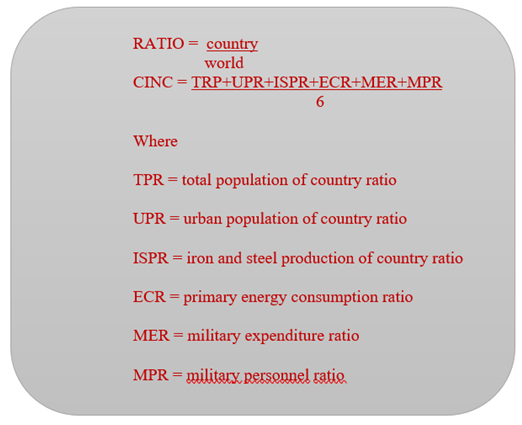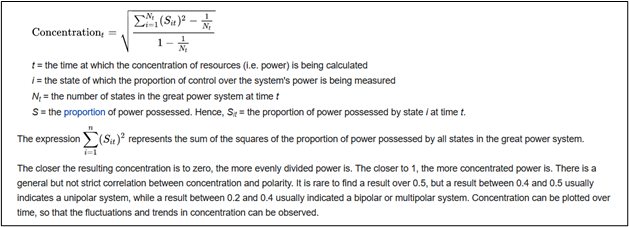Mathematics modeling
The Correlates of War Project was founded in 1963 by J. David Singer, a political scientist at the University of Michigan. The original and continuing goal of the project has been the systematic accumulation of scientific knowledge about war.
The Composite Index of National Capability (CINC) is a statistical measure of national power created by Singer for the Correlates of War project in 1963. It uses an average of percentages of world totals in six different components. The components represent demographic, economic, and military strength. National power is defined as the sum of all resources available to a nation in the pursuit of national objectives. Assessing the national power of states/nations/political entities was already a matter of relevance during the classical antiquity, in the middle ages or today.
More recent studies tend to use the (CINC) score, which “focuses on measures that are more salient to the perception of true state power” beyond GDP. It is still “among the best-known and most accepted methods for measuring national capabilities.” The CINC only measures hard powers and may not represent soft powers or total national power.
In Singer’s statistical method, each component is a dimensionless percentage of the world’s total.
The Singer’s formula is the following:

Power in international relations is similar to what wealth is to economics. Power and wealth are relative concepts. There is no absolute power just as there is no absolute wealth. Power and wealth are relative, social conventions, their measurement depends on social circumstances. Power and wealth are dynamic, because their content and attributes change over time. Both power and wealth are means, not goals in and of themselves
Polarity in international relations is a way, in which power is distributed within the international system. It describes the nature of the international system at any given period of time. Some well-known types of systems: unipolarity (one center of power), bipolarity (two centers of power) and multipolarity for three or more centers of power. The type of system is completely dependent on the distribution of power and influence of states in a region or globally.
The Correlates of War project used a systemic concentration of power formula to calculate the polarity of a given great power system. The formula was developed by J. David Singer et al. in 1972.
Measuring the power concentration, using Singer’s formula:

There are quite many other researchers exploring statistical models of power and national capability. The American A. F. K. Organski and Jacek Kugler (The War Ledger,1980) offered a formula for measuring national power, as:
National Capacity = GNP ×Political Capacity
According to Organski and Kugler, GNP is the single best predictor of potential power (as control over resources). Political capacity is a multiplier of physical power; it determines which percentage of the actual resources that a state produces are actually available to the government. Organski and Kugler offer a definition of political capacity in terms of tax extraction ratio, that is:
Political Capacity (PC) = Actual Tax Extraction Potential Tax Extraction
Other Western researchers can be named like Clifford German and Wilhelm Fucks. Many Chinese academic institutions and universities have developed various power indexes to measure power and national capabilities.


